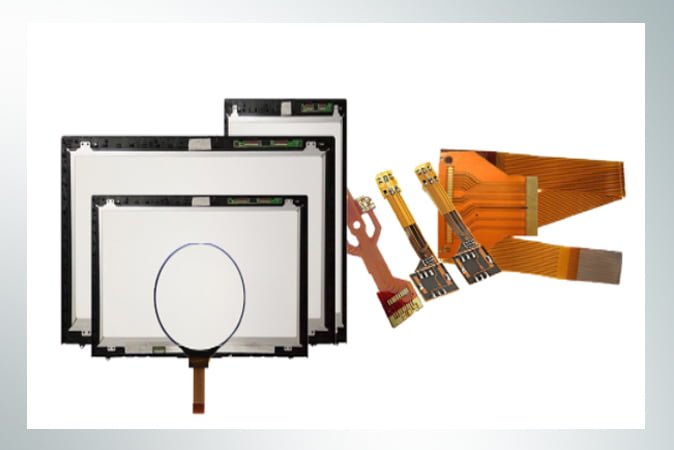MIPI (Mobile Industry Processor Interface), LVDS (Low-Voltage Differential Signaling), SPI (Serial Peripheral Interface), MCU (Microcontroller Unit), and RGB (Red-Green-Blue) are all interfaces used in LCD displays. Each of these interfaces serves a different purpose and has its own strengths and weaknesses.
We do tailor-made LCD solution, custom LCD module is our advantages, square TFT LCD display or round LCD module, We can customize the LCD interface you need according to the size of the LCD you need, or we can provide you with an adapter board for the LCD interface, please contact us for many customization needs.
1. MIPI (Mobile Industry Processor Interface)
MIPI (Mobile Industry Processor Interface) is a serial communication interface used in mobile devices, including LCD displays. MIPI is designed to reduce power consumption and increase bandwidth, making it a popular choice for high-resolution displays. MIPI supports multiple data lanes, allowing it to transmit large amounts of data quickly. MIPI also supports features such as display command set (DCS) and display data channel (DDC), which allows for easy communication between the display and the controller.
- Data Rate: MIPI offers very high data rates, supporting the transmission of full HD video and high-quality graphics.
- Power Efficiency: It is highly power-efficient, making it suitable for battery-powered devices.
- Complexity: MIPI interfaces are more complex to implement due to their high-speed nature and require careful design considerations to avoid signal integrity issues.
2. LVDS (Low-Voltage Differential Signaling)
LVDS (Low-Voltage Differential Signaling) is a high-speed, low-power interface used for LCD displays. LVDS is known for its low electromagnetic emissions, making it ideal for use in sensitive applications such as medical equipment or aerospace. LVDS typically uses differential signaling, which helps reduce noise and improve signal integrity. It is commonly used in industrial and medical applications where high reliability and noise immunity are important.
- Data Rate: LVDS supports high data rates and can handle resolutions up to 4K, making it suitable for high-definition displays.
- Noise Immunity: It is known for its excellent noise immunity, providing reliable data transmission over long distances.
- Application: LVDS is commonly used in applications where high resolution and low power consumption are important, such as in industrial displays and automotive systems.
3. MCU (Microcontroller Unit Interface)
MCU (Microcontroller Unit) is a small computer on a single integrated circuit that contains a processor core, memory, and input/output peripherals. MCUs are often used to control LCD displays, and they typically use one of the other interfaces (such as SPI or MIPI) to communicate with the display.
- Data Rate: The data rate is relatively low, making it suitable for displays with basic graphics, like text or simple icons.
- Ease of Use: MCU interfaces are easy to implement and require fewer pins, which reduces the overall complexity and cost.
- Application: This interface is typically used in smaller displays for simple applications, such as home appliances, digital clocks, and simple control panels.
4. RGB (Red, Green, Blue Interface)
RGB (Red Green Blue) is a color model used to create images on LCD displays. RGB interfaces typically use separate data lines for each color (red, green, and blue), allowing for precise control over the color and brightness of each pixel on the display. MCU is a microcontroller unit that contains a processor, memory, and other peripheral components. It is used to control the display and perform other tasks in the system.
- Data Rate: RGB interfaces offer high data rates, making them suitable for applications that require fast refresh rates, such as gaming displays.
- Color Depth: They support a wide color depth, providing vibrant and accurate color reproduction.
- Application: RGB interfaces are often found in devices that require high-quality video output, like gaming consoles, televisions, and professional monitors.
5. SPI (Serial Peripheral Interface)
SPI (Serial Peripheral Interface) is a synchronous serial communication interface used to transfer data between microcontrollers and peripheral devices, including LCD displays. SPI is known for its simplicity and versatility, making it a popular choice for low-speed applications that don’t require high bandwidth or complex protocols. It is commonly used in small displays and other low-power applications.
- Data Rate: SPI offers moderate data rates, which are sufficient for displays with simple graphics and low refresh rates.
- Pin Count: It requires fewer pins compared to other interfaces, making it ideal for compact devices.
- Application: SPI is commonly used in small displays, such as those found in wearable devices, handheld gadgets, and simple user interfaces.
In summary, MIPI and LVDS are high-speed, low-power interfaces commonly used in LCD displays, while SPI is a simple, versatile interface often used in low-speed applications. MCU is a small computer used to control the display, and RGB is a color model used to create images on the display.
The different lcd display interface depends on different products applications, including small TFT displays, SPI LCD display modules, TFT color LCD modules, custom TFT LCDs (HDMI interface or others), and LCD display panel modules with single color. Each of these types has its own unique characteristics. For example, small TFT displays are often used in handheld devices and wearables, while SPI LCD display modules are ideal for applications that require low power consumption and simple interfaces. TFT color LCD modules are commonly used in industrial and medical applications where color accuracy is critical, while custom TFT LCDs are designed to meet specific requirements for size, resolution, and other parameters.
The following are several typical representative products, in fact our customized product line includes 1.3 inch-24 inch TFT LCD display panel:
| MCU TFT LCD DISPLAY MODULE |
|
| TFT LCD SPI PANEL |
|
| LCD MIPI DISPLAY |
|
| RGB LCD SCREEN PANEL |
|
| LVDS LCD SCREEN |
|
| EDP LCD表示パネル |
|
会社概要
Rjoytek(RJY Display)は2014年に設立され、ワンストップでのLCD研究開発及び販売ソリューションに注力しております。お客様が従来多数のサプライヤー探索に労力を要されていた実態を踏まえ、当社は資源を統合し、自社で2つのLCD製造工場を保有する基盤に加え、専任部門を設置してLCD制御ボードの調達、ソフトウェア開発ベンダー、各種組立部品サプライヤーまでを手配いたします。現在ではLCD表示パネル・制御ボード・付属ケーブル・ソフトウェアサポート・ロゴカスタマイズなど、成熟した提供能力を有しております。一括対応により、お客様の時間とコストを大幅に削減します。もちろんこれらのサービスは全てオプションであり、既に成熟した調達先ネットワークをお持ちの場合でも、既存サプライヤー様と連携し高品質なLCDディスプレイを提供することが可能です。
当社の強み: 完全カスタマイズ ソリューションに加えて、 他社製制御ボードの供給も可能であり、LCDスクリーンと合わせて当社から一括調達いただけます。ワンストップサービスが私たちの目標です。
- 製品サイズ・タッチスクリーン・デジタルケーブル・制御ボードなど、多岐にわたるカスタマイズに対応;
- ISO9001、ISO45001、REACH、CEなど、各種製品認証及び工場認証を取得;
- 2つの自社工場により、短納期かつ迅速な生産体制を実現;

